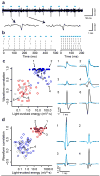Neuron-type-specific signals for reward and punishment in the ventral tegmental area
- PMID: 22258508
- PMCID: PMC3271183
- DOI: 10.1038/nature10754
Neuron-type-specific signals for reward and punishment in the ventral tegmental area
Abstract
Dopamine has a central role in motivation and reward. Dopaminergic neurons in the ventral tegmental area (VTA) signal the discrepancy between expected and actual rewards (that is, reward prediction error), but how they compute such signals is unknown. We recorded the activity of VTA neurons while mice associated different odour cues with appetitive and aversive outcomes. We found three types of neuron based on responses to odours and outcomes: approximately half of the neurons (type I, 52%) showed phasic excitation after reward-predicting odours and rewards in a manner consistent with reward prediction error coding; the other half of neurons showed persistent activity during the delay between odour and outcome that was modulated positively (type II, 31%) or negatively (type III, 18%) by the value of outcomes. Whereas the activity of type I neurons was sensitive to actual outcomes (that is, when the reward was delivered as expected compared to when it was unexpectedly omitted), the activity of type II and type III neurons was determined predominantly by reward-predicting odours. We 'tagged' dopaminergic and GABAergic neurons with the light-sensitive protein channelrhodopsin-2 and identified them based on their responses to optical stimulation while recording. All identified dopaminergic neurons were of type I and all GABAergic neurons were of type II. These results show that VTA GABAergic neurons signal expected reward, a key variable for dopaminergic neurons to calculate reward prediction error.
Figures




Comment in
-
Reward: High expectations for GABA.Nat Rev Neurosci. 2012 Feb 8;13(3):150-1. doi: 10.1038/nrn3194. Nat Rev Neurosci. 2012. PMID: 22314440 No abstract available.
References
-
- Schultz W, Dayan P, Montague PR. A neural substrate of prediction and reward. Science. 1997;275:1593–1599. - PubMed
-
- Schultz W. Behavioral theories and the neurophysiology of reward. Annu Rev Psychol. 2006;57:87–115. - PubMed
-
- Swanson LW. The projections of the ventral tegmental area and adjacent regions: a combined fluorescent retrograde tracer and immunofluorescence study in the rat. Brain Res Bull. 1982;9:321–353. - PubMed
Publication types
MeSH terms
Substances
Grants and funding
LinkOut - more resources
Full Text Sources
Other Literature Sources
Molecular Biology Databases

